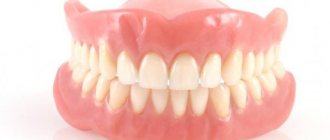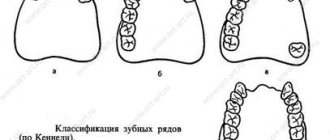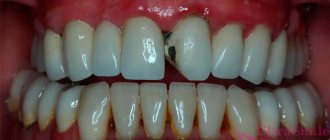Why can't we leave everything as it is?
When a person loses a tooth in the smile area, he usually tries to restore it - but with chewing teeth that are not visible, the situation is different. Many people think that if one chewing tooth is lost, then nothing bad has happened - the rest are in place, which means they can chew.
Each tooth in our jaw carries an important functional, and not just aesthetic, load. If the tooth is not restored, negative consequences will inevitably occur:
- improper distribution of the chewing load will lead to gradual destruction of the teeth next to the defect - after all, they will have to work for themselves and for the lost tooth;
- bone tissue atrophy will occur due to the fact that there is no load during chewing;
- Bite defects will appear - if a tooth has been missing for years, then its row neighbors gradually begin to shift towards the empty space;
- chewing food will not be of sufficient quality, which over the years will lead to the development of problems with the gastrointestinal tract;
- bite defects will negatively affect the functioning of the temporomandibular joint, which will provoke neck pain, headaches, discomfort and pain when opening the mouth or chewing, even insomnia;
- Diction problems will appear.
But how to place a tooth if there is no root?
The main goals of prosthetics are to return the patient to the ability to chew food normally, restore the aesthetics of a smile, and prevent further tooth decay due to chewing overload. Here are 3 main ways to insert a tooth:
- removable prosthetics
- making a prosthesis from nylon, acrylic, silicone, Acry Free material; - bridge prosthetics
- the classic technique involves grinding two adjacent teeth with a defect, which will be used as supports for a prosthesis that replaces a lost tooth. It is also possible to install a bridge on implants; - installation of an implant
followed by loading with a crown.
Sometimes patients ask if it is possible to grow a tooth in any way without a prosthesis? Alas, no - if a tooth is removed or lost along with the root, then there is literally nothing to build up. The methods of tooth extension, which we also talked about, are effective only in cases where there is a root and some volume of the crown has survived.
Removable dentures
For centuries, dentists have been solving the problem: if there is no root, how to make a tooth? The first option, which has been around for thousands of years, is removable dentures. They were found during excavations of Egyptian tombs and in the territory of the Mayan Indians, so this is one of the most ancient methods of restoring teeth.
What are its advantages? Firstly, it is fast - making a prosthesis takes from 3 to 7 days, depending on the complexity of the work; secondly, it is inexpensive compared to bridges or implants. Modern materials for removable dentures make it possible to create structures similar to natural teeth, but they still have disadvantages:
- service life even with careful care is about 5–7 years;
- constant risk of prosthesis falling out and the need for additional fixation;
- the prosthesis does not stop bone atrophy;
- does not allow the chewing load to be evenly distributed;
- sometimes causes diction defects;
- there is a risk of allergies to acrylic, nylon, silicone and other materials.
Removable prosthetics are now being used if there are absolute contraindications to the installation of bridges or implants, or as a temporary measure while the patient waits for a permanent prosthesis to be made.
Who can use the quota
Who is entitled to a quota for dental prosthetics? It can be received by socially vulnerable segments of the population - pensioners, disabled people, disabled children, people with severe pathologies. The list should also be supplemented by pensioners of the Ministry of Internal Affairs and those who retired from military service, heroes of the Second World War, home front workers, Heroes and Veterans of Labor, Heroes of the USSR and the Russian Federation, mothers of many children, etc.
You need to know that there are several programs for free dental prosthetics - federal and regional. The federal list includes only those pensioners who retired from government, military service and the Ministry of Internal Affairs. Regions or subjects of the Russian Federation supplement this list with other categories of citizens. You can use the quota for free prosthetics once every 5 years.
Bridges
The good old classic that dentists offer when they see that a root is missing. Bridges do not need to be removed from your mouth every day to be cleaned, unlike removable dentures, they will last 10-12 years with proper care and are much better at restoring chewing function. Modern materials are quite effective at restoring a beautiful appearance to a smile. The price and production time of such a prosthesis is higher than that of a removable prosthesis, but lower than that of an implant.
What are the disadvantages of this technique?
- With classic prosthetics relying on your own teeth, due to the uneven distribution of the load during chewing, the supporting teeth under the bridge gradually begin to collapse.
- Bone atrophy also does not stop.
- The denture requires special cleaning products - pipe cleaners, brushes, etc., otherwise food debris and plaque will accumulate under it.
- The implant-based method is not always possible - if one tooth or two in a row is lost, the doctor will not remove adjacent healthy teeth in order to put implants in their place.
Frequently asked questions to the doctor
Implant rejection
I heard that implants are rejected in most cases, is this true?
In fact, such a situation occurs. In rare cases, the body may not accept the implant. But still, as practice shows, in 95% of cases such surgical intervention is successful, and the person receives beautiful and straight teeth. Don’t be afraid, you just need to choose a good specialist and clinic.
Prosthetics
I would like to know why prosthetics are necessary?
Prosthetics are primarily necessary to ensure that chewing function is restored. First of all, this includes gastroenterological indications, because if the food is chopped poorly, the stomach will begin to work incorrectly.
Dental implantation
A provocative question: is it possible to put a crown on the root of a tooth? Yes, if this root is an artificial implant made of titanium alloy or even zirconium. Installing an implant solves almost all problems with tooth loss:
- stops bone atrophy;
- completely restores the natural distribution of chewing load;
- no damage to neighboring teeth;
- excellent aesthetic result;
- implant service life - from 25–30 years to lifelong;
- a large number of possible options for creating crowns - ceramics, metal-ceramics, solid zirconium or zirconium with ceramic lining;
- ease of care, no different from the hygiene of natural teeth.
Prosthetics with zirconium crowns –
The next option for aesthetic prosthetics of the front teeth is ceramic crowns made of zirconium dioxide (such crowns are called zirconium). This material has the strength of metal, and therefore crowns made from it do not require an internal metal frame. The absence of the latter should certainly provide more aesthetic options when using prosthetics with zirconium crowns, but in reality, not everything is so simple, and you can find a huge number of patients who are dissatisfied with such prosthetics.
Let's start with the fact that there are 2 types of zirconium crowns.
- The first option assumes that only the internal frame reinforcing the structure is milled from zirconium dioxide, which will then be covered with layers of ceramic mass (porcelain). The disadvantage of this option is that the porcelain often chips. According to statistics, after 3 years, chips occur in at least 6% of patients with zirconium crowns, and after 5 years – in at least 10% of patients.
In addition, if for this version of crowns a cheap version of zirconium dioxide blocks is used (milky white, not transparent, i.e. translucent), then even after applying layers of porcelain, the crowns end up looking unnatural, because have a milky tint.Clinical case No. 4 –
Note the unnatural color (no color gradient from the neck of the tooth towards the incisal edge of the incisors) that is present on adjacent teeth. In addition, there is no transparency of the cutting edges, i.e. crowns essentially look like plastic. Keep in mind that in most clinics in our country, zirconium crowns are made at approximately this low professional level.
- The second option is monolithic zirconium crowns “Multi-layer”. Monolithic - means that the crowns will be made entirely of zirconium dioxide, i.e. without applying layers of porcelain (accordingly, in this case there is no problem of ceramic chipping). But the most important thing is that in this case more expensive “Multi-layer” zirconium dioxide blocks will be used.
Such blocks have a gradient of color and transparency, which makes it possible to mill crowns from them, which will also have a gradient of color and transparency, varying from the neck of the tooth and towards the incisal edge. Accordingly, the presence of a gradient of color and translucency will make the crowns on the front teeth more similar to real ones.Clinical case No. 5 (multi-layer) –
In the photo above you can see newly made “Multi-layer” zirconium crowns, which still need to be fixed in the oral cavity. The crowns are made for the entire dentition - they are single crowns, with the exception of a 3-unit zirconia bridge in the side of the jaw (where you can see the artificial pink gum). Pay attention to the natural color and transparency that change - in the direction from the necks of the crowns to the cutting edge.
Is it worth it or not to make zirconium crowns?
Everything will depend on the specific situation in the oral cavity. In general, zirconium dioxide crowns are a good choice if you need to replace an entire group of front teeth at once (for example, 6-8 or more). This is because the dental technician only has a limited range of color options when working with zirconia. Those. If you have a complex tooth color, then one or more crowns will almost always differ from your neighboring natural teeth.
But this problem is solved if you do all the front teeth at once, in which case they will all look the same. And in this case, of course, you should pay attention to the fact that the crowns are made monolithic - from “Multi-layer” zirconium dioxide blocks, and not from cheap milky-white blocks that are not translucent. BUT, again, sometimes you have to deviate from this rule if the patient only needs 1-2 single crowns on the front teeth.
In this case, only the frame is milled from “Multi-layer” zirconium dioxide blocks, and then layers of porcelain are applied to it. Despite the higher risk of chipping, this technology will allow the dental technician to make crowns more similar to neighboring teeth, because When working with porcelain, the dental technician has a much wider range of color options. The main thing here is that cheap milky-white zirconium dioxide, which does not have translucency, is not used for the frame of the crowns.
The cost of zirconium crowns - the cost of 1 zirconium crown averages from 30,000 to 40,000 rubles. In the regions you can find prices starting from 25,000 rubles, but for this price the crowns will be made of cheap zirconium dioxide of a milky white color, which is not translucent. At the same time, we will next tell you about Emax ceramic crowns, the price of which averages from 25,000 to 30,000 rubles, and this despite the fact that they also benefit in aesthetics.
Zirconium dioxide with increased aesthetics:
Clinical case No. 6 –
Clinical case No. 7 –
When choosing ceramic zirconium crowns for your front teeth, you must ask your doctor for information about the manufacturer of the zirconium dioxide blocks from which your crowns will be milled. These should be translucent/pre-colored zirconium dioxide blocks (“multi-layer”) - preferably such as Katana® UTML (Japan) or Prettau® Anterior (Germany).
For more information about the various options for manufacturing zirconium crowns, read the article: → Options for manufacturing zirconium crowns, prices"
What to choose?
What to install if there is no root - a removable denture, a bridge or an implant? The dentist will select prosthetic options based on the condition of the oral cavity and the presence of relative or absolute contraindications. However, today doctors most often offer implant prosthetics. It has only two disadvantages compared to other types - a higher price and a longer period of prosthetics with several stages. However, this is compensated by excellent, long-term and predictable results. In addition, implantation technologies are constantly being improved; there are already techniques and implants that can significantly reduce the time of prosthetics.
Veneers and Lumineers
Veneers and lumineers can be used as aesthetic options for dentures on the front teeth. Veneers are very thin shells of porcelain that are given a color similar to the natural color of the patient's teeth. Veneers completely match the shape of a natural tooth. Such plates are attached to the front surface of the tooth.
Lumineers are transparent and very thin plates about 0.15 mm thick. Placed on the front surface of the tooth. This cosmetic procedure is non-invasive, quick, painless and long lasting.
These qualities determine the indications for the installation of veneers or lumineers:
- Crack and small chip of a tooth;
- Yellowing or darkening of tooth enamel;
- Uneven frontal surface;
- Crooked teeth.











